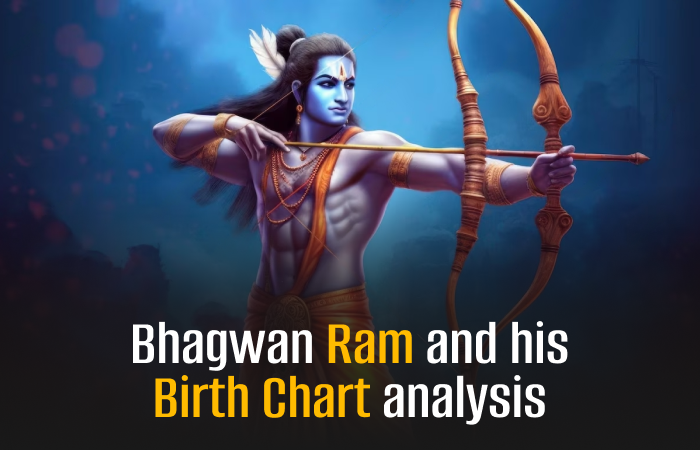Bhagwan Ram and his Birth Chart Analysis!

Shri Ram is the epitome of virtuousness, heroism and truth. He is the main character in the Hindu epic “Ramyana” and was the seventh incarnation of Vishnu.
Bhagwan Ram is highly revered among Hindu deities and is considered the supreme deity in some Hindu sects, not just an avatar. He is also known by various other names, such as Raghava, Koshlendra, Ramachandra, Ramabhadra, Raghupati, Kaushalya Nandan, Dashrath Nandan, Ayodhyapati, Sitapati, Janakiramana, Raghuveer, Rajeevochan, Janakivallabha, Raghunath, and many, many more.
He is a protector of holy people, women, and all of mankind. This ideal king, often referred to as Maryada Purushottam, upholds righteousness (dharma) and the highest social norms. He has a peace-loving, spiritual, honourable, and wise personality.
A self-sacrificing individual, he always prioritises the well-being of respected elders, such as parents and gurus, as well as the state. In a time when having multiple spouses was common, he adhered to the dharma of having only one marriage in a lifetime and was completely devoted to his consort, Mata Sita. Even today, he is considered the ideal husband, ideal son, ideal brother and ideal king, and these attributes are to be believed to be the epitome of dharma.
Interestingly, the exact birth year of Bhagwan Ram is not specified in Valmiki’s Ramyana or other Vedic scriptures. Despite this, the unique planetary positions in Bhagwan Ram’s horoscope are considered extraordinary and occur only once in many thousands of years. In this analysis, we explore the Vedic Astrology perspective on Bhagwan Ram’s horoscope.
Birth Chart Analysis of Bhagwan Ram
Before analysing the birth chart of Bhagwan Shri Ram, let us first tell you about the sources of his birth details.
Source of the Chart
We learn about the birth chart details from the verses written by Valmiki in Bala Kanda Chapter 18, Verses 8 to 9.
तो यज्ञे समाप्ते तु ऋतूनां षट् समत्ययुः |
ततश्च द्वादशे मासे चैत्रे नावमिके तिथौ || १–१८–८
नक्षत्रेऽदितिदैवत्ये स्वोच्चसंस्थेषु पंचसु |
ग्रहेषु कर्कटे लग्ने वाक्पताविंदुना सह || १–१८–९
According to the verses, after a year of completion of the Aswamedha sacrifice, on the ninth day (Navami Tithi) of the Chaitra month, and under the Punarvasu Nakshatra with Aditi as the deity, Kausalya gave birth to Ram. During this time, five of the nine planets were in favourable positions in their own houses, and Jupiter and the Moon were in the ascendant in Cancer. Let us know about the positions of various planets and their Dashas and how they affected the course of events in his life.
Mercury And Saturn Placement
In Bhagwan Ram’s birth chart, the position of Mercury as the third lord in the 10th house indicates success for younger siblings. Additionally, as Mercury, the 12th lord, influences the 4th house, it signifies Bhagwan Ram’s exile. Saturn in the 4th house, which also represents separation from home, aligns with events in Bhagwan Ram’s life. Saturn in the 4th house also serves as the 7th lord in that house, suggesting Sita’s journey to the forest with Bhagwan Ram.
Saturn’s presence in the 4th house contributes to Bhagwan Ram’s steady and enduring nature but complicates his married life and ascension to the throne by affecting the 7th and 10th houses.
Considering Mercury in the 11th house, it denotes intelligence in the house of gains and friends. Bhagwan Ram’s life reflects this, as he had supportive friends during his struggles to rescue Sita. However, the dual role of Mercury as the lord of the 12th house (loss and long journeys) and the third lord (brothers) contributed to the loss, exile, and the throne going to Bhagwan Ram’s brother.
Now that we have seen the positioning of the planets, let us see how the Dasa of the planets played an important role in the life of Shri Ram.
Dasa of Planets
During the time of Bhagwan Ram’s birth, the ruling period (Dasa) was Jupiter. The total years for different planetary periods covering seven planets and two nodes are considered 120 years in Vedic astrology, which is seen as the maximum natural life period for a human being.
Bhagwan Ram was born in the fourth pada of Punarvasu, a Nakshatra in Cancer, and the exaltation point for Jupiter is at the 5th degree of Cancer. There is a conjunction of Jupiter and the Moon in his chart. Although determining the exact degree of this conjunction is complex, it is reasonable to estimate that the balance of Jupiter Dasa at birth was less than 4 years.
Bhagwan Ram’s 19-year Saturn Dasa began when he was 4 years old and ended when he was 23 years old. The seventh house in astrology represents the spouse. In Bhagwan Ram’s chart, the Lord of the Seventh House, Saturn, is in the fourth house. Mars, the Lord of the fourth and eleventh houses, is in the seventh house in its exalted position. Additionally, exalted Jupiter and well-placed Moon aspect the seventh house, and Venus, the significator for the spouse, is in the ninth house in an exalted position.
Bhagwan Ram’s marriage to Mata Sita took place during Saturn’s Dasa. Although there are no afflictions to the seventh house and it is well protected, the presence of Mars, even though exalted, is associated with Mata Sita’s separation from Bhagwan Ram and the suffering they both endured. Despite leaving royal life at a young age, Bhagwan Ram and Mata Sita were a content couple in the forest. The abduction by Ravana caused significant suffering for both.
The tenth house in the chart is aspected by exalted Mars and Saturn, and the exalted Sun is placed in the tenth house. These positive relationships indicate extraordinary military skills, respect for people’s opinions, concern for their welfare, and the ability to rule as an emperor.
Mars, the Lord of the Fifth House, is exalted in the Seventh House. The fifth house is powerfully aspected by Jupiter and Moon, leading to the birth of Bhagwan Ram’s sons, Lava and Kusa, who surpassed their own father in courage and valour.
The Unique Horoscope of Prabhu Ram
Even though Bhagwan Ram was born as a human, he displayed divine qualities. His horoscope is not only exceptional but also considered perfect. What makes it stand out is that all five planets are exalted, a rarity in astrology. Having five or six exalted planets, as per Vedic astrology texts, is said to result in the person becoming an emperor or a mighty king.
In Sarvartha Chintamani, a classical Vedic astrology book, Chapter X discusses raja yoga. It mentions that if six planets are in exaltation, the person will become an emperor. If the five planets are in exaltation and Jupiter is strongly placed in Lagna, the person will become a “mighty sovereign.” In Bhagwan Ram’s horoscope, Jupiter is exalted in Lagna, and the other five planets are also in exalted positions.
Similarly, in Phaladeepika Chapter VII, which covers “Maharaja Yogas,” it is stated that a person born with three or more planets in exaltation or own houses and in quadrants will become a widely renowned king. Bhagwan Ram’s chart fulfils this condition with the five exalted planets placed in the first, fourth, seventh, ninth, and tenth houses, making four of them in quadrants and Venus in a trine.
How did Bhagwan Ram win the battle against Ravan?
Bhagwan Ram’s horoscope shows a powerful Gaj-Kesari Yoga in the first house, indicating many relations, politeness, generosity, and leadership qualities. The fourth house’s exalted position and powerful Saturn grant him excellent knowledge of weapons. Exalted Mars in the seventh house makes him a skilled martial artist and a conqueror in battles. The sun in Aries in the tenth house contributes to his strength and emperor-like qualities.
Although the tenth house’s lord is exalted in the seventh house, the Sun-Saturn opposition in the 4th and 10th axes leads to Bhagwan Ram’s exile from Ayodhya for fourteen years, depriving him of family, home, power, and authority.
The sixth house, representing battles, has an exalted Jupiter, the lord of battle, in conjunction with the Moon. Rahu in the sixth house ensures victory over enemies, making Bhagwan Ram a Shatrunjayi (victory over enemies). The exalted ninth house lord, with the aspect of the exalted fifth house lord, makes him Maryada-Purushottam.
Of course, astrology played a big role in shaping the events of his life. But his victory and his greatness came not only from astrology but also from personal choices and, more importantly, personal sacrifices. That is why he is ideal and is known as Purushottam (best among all men), the reason our elders and wise persons always guide us to follow his footprints.









